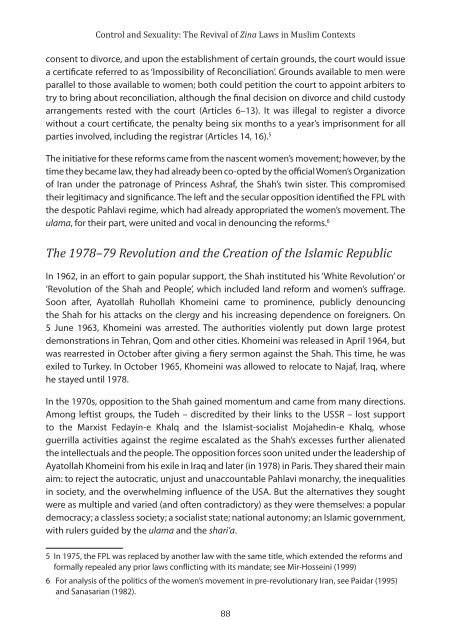control and sexuality
control and sexuality
control and sexuality
- No tags were found...
You also want an ePaper? Increase the reach of your titles
YUMPU automatically turns print PDFs into web optimized ePapers that Google loves.
Control <strong>and</strong> Sexuality: The Revival of Zina Laws in Muslim Contextsconsent to divorce, <strong>and</strong> upon the establishment of certain grounds, the court would issuea certificate referred to as ‘Impossibility of Reconciliation’. Grounds available to men wereparallel to those available to women; both could petition the court to appoint arbiters totry to bring about reconciliation, although the final decision on divorce <strong>and</strong> child custodyarrangements rested with the court (Articles 6–13). It was illegal to register a divorcewithout a court certificate, the penalty being six months to a year’s imprisonment for allparties involved, including the registrar (Articles 14, 16). 5The initiative for these reforms came from the nascent women’s movement; however, by thetime they became law, they had already been co-opted by the official Women’s Organizationof Iran under the patronage of Princess Ashraf, the Shah’s twin sister. This compromisedtheir legitimacy <strong>and</strong> significance. The left <strong>and</strong> the secular opposition identified the FPL withthe despotic Pahlavi regime, which had already appropriated the women’s movement. Theulama, for their part, were united <strong>and</strong> vocal in denouncing the reforms. 6The 1978–79 Revolution <strong>and</strong> the Creation of the Islamic RepublicIn 1962, in an effort to gain popular support, the Shah instituted his ‘White Revolution’ or‘Revolution of the Shah <strong>and</strong> People’, which included l<strong>and</strong> reform <strong>and</strong> women’s suffrage.Soon after, Ayatollah Ruhollah Khomeini came to prominence, publicly denouncingthe Shah for his attacks on the clergy <strong>and</strong> his increasing dependence on foreigners. On5 June 1963, Khomeini was arrested. The authorities violently put down large protestdemonstrations in Tehran, Qom <strong>and</strong> other cities. Khomeini was released in April 1964, butwas rearrested in October after giving a fiery sermon against the Shah. This time, he wasexiled to Turkey. In October 1965, Khomeini was allowed to relocate to Najaf, Iraq, wherehe stayed until 1978.In the 1970s, opposition to the Shah gained momentum <strong>and</strong> came from many directions.Among leftist groups, the Tudeh – discredited by their links to the USSR – lost supportto the Marxist Fedayin-e Khalq <strong>and</strong> the Islamist-socialist Mojahedin-e Khalq, whoseguerrilla activities against the regime escalated as the Shah’s excesses further alienatedthe intellectuals <strong>and</strong> the people. The opposition forces soon united under the leadership ofAyatollah Khomeini from his exile in Iraq <strong>and</strong> later (in 1978) in Paris. They shared their mainaim: to reject the autocratic, unjust <strong>and</strong> unaccountable Pahlavi monarchy, the inequalitiesin society, <strong>and</strong> the overwhelming influence of the USA. But the alternatives they soughtwere as multiple <strong>and</strong> varied (<strong>and</strong> often contradictory) as they were themselves: a populardemocracy; a classless society; a socialist state; national autonomy; an Islamic government,with rulers guided by the ulama <strong>and</strong> the shari’a.5 In 1975, the FPL was replaced by another law with the same title, which extended the reforms <strong>and</strong>formally repealed any prior laws conflicting with its m<strong>and</strong>ate; see Mir-Hosseini (1999)6 For analysis of the politics of the women’s movement in pre-revolutionary Iran, see Paidar (1995)<strong>and</strong> Sanasarian (1982).88


